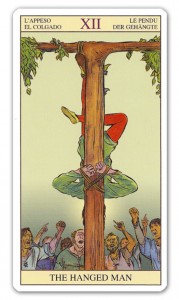A Different Point of View
The Tarot of the New Vision is a fascinating deck from the fine folks at Lo Scarabeo. This deck shows traditional Rider-Waite-Smith images from the back. Finally, a glimpse of what is going on behind the scenes.
On Tuesday, the blog entry was about making meanings and one of the suggestions was to consider what happened just before and what might happen just after the scene in the card. Well, add to that list: what is going on behind the scenes?
Since we are talking about seeing things from a different point of view, what better card to explore than the Hanged Man?
Wow. This really changed the energy and feel of the card for me. What are your thoughts?
Here are some observations from the deck designer, Giordano Berti.
The meanings of this figure are many and not immediately clear. It obviously does not express prudence, as someone affirmed. It is decidedly more accurate to talk of suffering—adding, however, that this condition could also derive from an individual coice. But who would accept torture like this? Soemone who is mad, maybe, or someone out of the ordinary. In fact, hanging from a pole reminds us of certain Shamanistic rituals aimed at taking the Initiated inot a higher dimension of being by putting him direct touch with supernatural entities.
Psychologically, the Hanged Man represents maturity due to the experience of a painful episode. In this case, the title of novice or “new plant” cannot be applied to the Hanged Man, as it is usually attributed to those who have just complete the initiation rite.
There are a lot of instances in life, which, by provoking deep suffering, open the mind to a greater awareness. Until this awareness is deep in your memory, it is necessary to carry on in search of yourself without waiting for the easing of the pain (which reduces mental clarity).
In everyday life, the Hanged Man could even represent a voluntary sacrifice for someone or for the benefit of something else; a symbolic crucifixion that is not always understood. It is probably concerns a temporary situation, not martyrdom. In fact, green fronds shoot out the tree’s branches—meaning that the sacrifice, whether accepted or not, has given back life to a situation that was languishing.












[…] This post was mentioned on Twitter by Cat 'N Owl and Tarot Fans, barbaramoore. barbaramoore said: A look at things from the Hanged Man's point of view. http://www.llewellyn.com/blog/2010/09/a-different-point-of-view/ #tarot […]
The concept of this deck is very evocative and could be a great prompt for visual journaling.
My strongest reaction to this depiction of the Hanged Man was his hands. I had always imagined that this figure was holding something very precious, like his heart, something he was offering but in a hidden manner.
It was not uncommon for traitors to be hung upside-down (posthumously or otherwise) in the Middle Ages. Perhaps we can look at the hanged man as someone who has been betrayed by his beliefs or has ‘betrayed’ his traditional beliefs by seeking a higher wisdom, even if it entails suffering of some sort?
Changing one’s religion, political party, philosophical outlook, etc can make one unpopular-leading to a period of inner reflection (or stemming from one as well) or the feeling that one is being persecuted, or at least, the world has turned on it’s head. And everyone is looking at us!
I don’t think I like this idea. The direction of each card is significant. One thing about the RWS deck is that it is really the first card system to use images drawn in full perspective. Previous cards were usually flat or had little depth in the images. Smith drew the cards with significant horizons or significant objects blocking the view of the horizon. The iconography of these choices in the drawings has specific meaning.
Perspective drawings place the eye of the viewer in a specific location relative to the picture frame, and the objects and horizon inside the picture. This also constructs an “eye line” of the direction of view. BOTA doctrine places these eye lines on the “Cube of Space” which has significant correspondences to the qabalah. While I may not rely heavily on qabalah in my readings, I don’t think I can condone the reversal of these correspondences.
One very significant point: you say these cards are viewed from the back, showing you what is behind the scenes. I disagree. These drawings put you INSIDE the card, looking out. With the conventional deck, WE are outside, looking in through the frame into the scene on the card. This makes me uncomfortable for two reasons. First, I think the cards are portals into a path, reversing that makes them an exit. Secondly, the scenes supplied by the artist as we look out from the card are a substitute for our selves. In your example of the Hanged Man, in the place where I would normally view the card from, there is an angry mob pointing and laughing. I don’t envision myself as part of this mob. This card envisions ME as part of that mob.
I’ve always tended to view the Hanged Man as a Shamanic Sacrifice, and Echo of Odin sacrificing himself to himself and thus claiming the Runes; this of course if a very different vision.
.
And while I could not imagine reading with such a deck, I could very much see purchasing it as an “Art Deck” and paging through it to see what, if any new insights into old cards it provides, what cobwebs it shakes out of my Noggin. I had much the same reaction to the Tarot of the Eternal Night, while much to Dark to use for actual readings, the Deck was certainly beautiful and thought provoking. Blessings, BB.